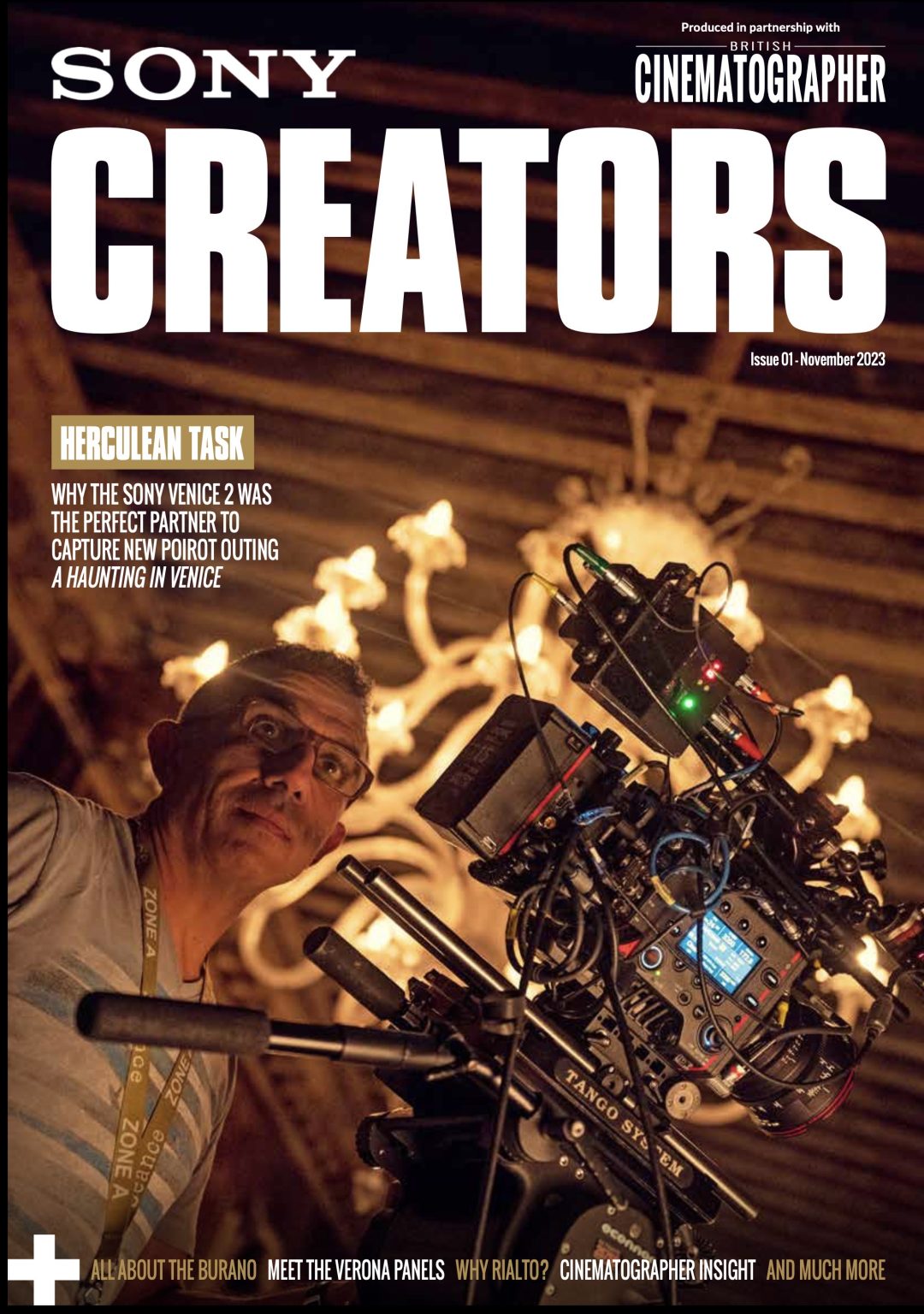HELPING HAND
Created by Sony to address the demand for a smaller camera without sacrificing quality, the Rialto Extension System has revolutionised large-format digital filmmaking.
The unique design of the Sony VENICE, introduced in 2017, revolutionised high-end digital motion picture photography. It’s been used as the main camera on everything from Avatar: The Way of Water to Top Gun: Maverick, and from Star Wars: Andor to The Witcher: Blood Origin.
But the 6K full-frame CMOS image sensor wasn’t just impressive for its wide latitude and colour gamut, its built-in ND filters, or its ability to capture in almost any format, including full 18mm-height Super35 Anamorphic and spherical and full-frame 24mm-height anamorphic and spherical. It was also designed to be detached from the main body of the camera.
The sensor area of the VENICE, and now the VENICE 2, which sports an 8.6K sensor, is attached to the main body via a ribbon connector. The key idea behind the design was size; people, in particular filmmakers, always want technology to be smaller, and while Sony’s αlpha still cameras also use 6K full-frame sensors, they don’t match the technology of a high-end Sony Cinema Line motion picture camera. If you cut back on size, you must cut back on other benefits, such as high frame rates. High-powered codecs in particular generate a lot of heat, so fans and heat dissipation technology alone make for a larger camera. So, while people wanted a small camera, Sony didn’t want to make sacrifices on quality.
Instead, the concept was proposed to detach the image sensor of the VENICE yet keep it tethered to the main body. It would have all the sensor modes, it would still have all the frame rates, and it would still offer all the benefits of the high-end camera, with no trade-offs. The Rialto Extension System was introduced in 2018, offering cabled separation of the image sensor block from the VENICE camera body by up to 5.5m (18 feet) with no degradation in image quality.
The original kit consisted of a front panel cover, an image sensor block case and a 2.7m (9 ft) cable with an additional 2.7m (9 ft) extension cable. The latest system exceeds this 5.5m maximum extension, offering an operating distance of 12m without a repeater thanks to a redesign of the cable, and so is capable of being used with a crane (a 3m umbilical cable is included for shorter distance work). It offers wider bandwidth to support the 8K sensor on the VENICE 2 but is also backwards compatible with the original VENICE (with some limitations).
Extensible thinking
The image sensor block can be housed in a much smaller camera mount than the VENICE, with an HD-SDI output and a 24V output for powering accessories such as lens servo motors and monitoring. Multiple screw holes on all surfaces make it easy to affix additional accessories and fit with a wide variety of rigs. The sensor block is small and light it can easily be used in handheld mode, or on a gimbal, or placed in tiny spaces, such as the cockpit of a fighter jet or a racing car. It’s been placed at the bottom of a popcorn bucket, for some rather unique shooting angles, and on a recent production was even passed between two moving vehicles, with the tether stretching through the window to shoot in first one, and then the other vehicle.
With an integral gyroscope sensor, the extension enables a spirit level indicator within the camera’s main monitor while information about horizontal and vertical tilt is recorded in the metadata and output through the camera’s SDI connector. This is ideal for VFX.
The sensor block sports four assignable buttons that can be set to functions such as change ND filter settings, REC Start/Stop, False Colour or exposure check, and switch to log C – allowing for easier operation with VENICE 2 without having to refer back to controls on the main camera body. However, the Extension system is also compatible with lens control systems like the ARRI cmotion system and focussing tools from Preston Cinema Systems, while companies like Wooden Camera have developed a line of accessories such as top plates, base plates, handles, power strips, and cage systems for the VENICE in Rialto mode. The camera and extension system is also compatible with Sony’s remote control panel and can be controlled via a smartphone via a WiFi adaptor, or on a computer connected over Ethernet.
Rialto in action
As well as allowing the VENICE to be used with lightweight stabilisation systems, the extension allows the use of larger lenses while maintaining a smaller profile and facilitates faster operation for motion-control rigs.
For example, Matthew Lewis, a talented young cinematographer, used the VENICE and Rialto for the Netflix film, Boiling Point. The 90-minute film was shot in one take by Lewis who moved around the kitchen-based set, shooting with the Rialto in a handheld position the entire time. Winning Best Cinematography at the 2021 British Independent Film Awards (BIFAs) for Boiling Point, Lewis had the VENICE in Rialto mode with Zeiss Supreme lenses on the handheld sensor, while the main camera was in a customised Easyrig on his back. Lewis actually ran through a full four of the 90-minute takes for director Philip Barantini, constantly moving through the restaurant, while avoiding showing his reflection in the many shiny surfaces. He only rested by leaning against one of the dining room tables, while his reloader, disguised as a diner, swapped memory cards in the camera.
DP Shane Kelly first used the Rialto on a commercial for Dell computers where he needed a POV shot from the perspective of the laptop. “I most recently used it on Richard Linklater’s new film Hitman where I had two cameras, a VENICE 2 and a VENICE 1 that always had the Rialto attached,” says Kelly. “I used the Rialto rig a lot on this show, mostly for getting into small spaces like a surveillance van with several people inside. It also allowed me to go handheld quickly and was invaluable for shooting in cars. You can operate a shot of the driver from the back seat and not put the operator in danger by requiring them to sit in the passenger seat. For small locations, you can get the camera closer to a wall and into places where a fully built camera can’t go.
“I’d love to see a shorter umbilical cable for those situations when the body and Rialto remain built on rails, but for car work, tight locations and handheld, the Rialto performs like nothing else out there,” he adds.
Another Rialto user is Ebba Hult, a Swedish cinematographer based in London. As well as brand and advertising work, her narrative work has gained recognition worldwide, having played at over 70 international film festivals. “I love the freedom and unintrusive nature of the Rialto system,” says Hult. “Before transitioning to moving image I used to do a lot of street photography, and the Rialto allows me to operate in a similar way. Combined with lightweight primes I find it a fantastic tool for fast-paced exterior shoots. I’ve used it primarily on fashion jobs where time is of the essence, and it enables me to quickly reposition for different types of angles, lending a unique perspective to the frames.”
So while the Rialto is capable of being used in extreme scenarios, in tight corners, and on cranes, it’s also able to bring the power of a Sony VENICE to the palm of your hand.
Find out more here.
–
Words: Michael Burns










